Blogpost for Jan 28
Today we woke up to a delicious breakfast at the Pink Hostel with yummy avocados and tomatoes. We had a big day ahead of us, so we ate early in the morning compared to usual. We left Accra for Cape Coast, a city a few hours away from us, where we visited the University of Cape Coast. While there, we listened to a lecture from Prof. Osei Kwarteng. Prof. Kwarteng is a former classmate of Abdulai, at the same university and now serves as the head of the university history department. Furthermore, he was selected by the government to lead the national curriculum development committee where he’s advocated for an initiative to increase history requirements in Ghana’s core curriculum. He informed us that by September, History would be made compulsory from the basic level upwards.
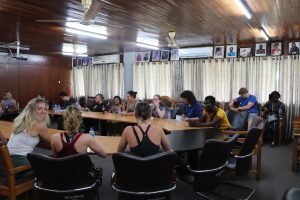
In the lecture we discussed many topics, beginning with the differences between the Atlantic, Saharan, and Arab slave trades. We learned that the slaves traded in the Trans-Saharan slave trade were primarily victims of the political model of slavery, as many were either prisoners of war, victims of pawnage, or criminals. We also learned that in the Arab trade slave traders went into the interior to capture people for slavery. These slaves were often castrated or made concubines. The slave trade led to significant depletion of the African population and also led to a 300-year developmental gap. The bulk of the information pertaining to the Trans-Atlantic trade was similar to what we had already covered throughout the course. But then, there was also domestic slavery and slave trade going on even after abolition.
Following the discussion of the three slave trades the Professor discussed the rationale behind studying history pertaining to the slave trade, as well as the dynamic that is made present between different groups of society when the slave trade is studied in depth. With regard to history, the professor spoke about the value he sees in understanding the past in order to ensure that the evils of the past are never repeated. Furthermore, while he identifies that there are evil people in the world, he firmly believes that understanding history makes us more well equipped to prevent evil behavior.
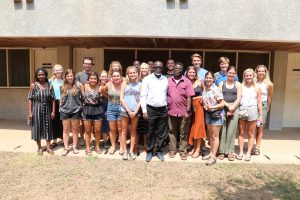
After our lecture we ate lunch at the cafeteria on campus, at the Sasakawa Global 2000 initiative launched by US president Jimmy Carter.
Elmina Castle
We all filled ourselves up and then left for Elmina Castle. Upon arrival we met with our tour guide, Alex, in the Portuguese Church in the center of the castle. Alex provided us with incredible insight into the history of Elmina Castle and the slave trading activity that took place on the coast. Alex explained that there are very few remaining castles along the coast, as the final three large remaining castles are the Danish castle in Accra, the British Cape Coast Castle, and Elmina Castle which was built by the Portuguese. Elmina castle was originally built with the intent to be used for gold trading, hence the original Portugal title meaning “The Mine” however the locals couldn’t pronounce the word and it soon morphed into “Elmina.” Regardless of the original intent of Elmina, it soon became a focal point of the West African slave trade. We learned that initially the Portuguese would attempt to obtain slaves themselves, but soon began to collaborate with local communities in order to obtain more slaves. Different countries would work with different ethnic groups as they all vied for access to the profitable trade. The Portuguese were at Elmina for 140 years, 110 of which were years where Elmina was dominated by slave trading activity. The Dutch were also here for 235 years. Alex ended his introductory speech by explaining how the abolition of slavery did little to stop the slave trade, as it continued illegally for 5 decades. Our visit to the archives in Tamale, where we came across documents on slavery, dating to as late as 1930s is testament to its continued practice despite abolition.

Our tour began with a visit to two different cells used to punish people at the castle. One cell was used for Europeans and the other cell was used for slaves. The cell used for Europeans had ample access to ventilation and light, while the slave cell was almost completely black and non-ventilated.
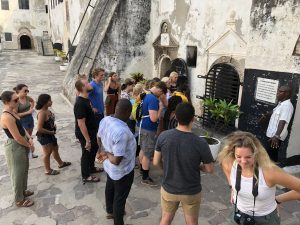
We learned that slaves would be left in their cell with no food or water until they either succumbed to starvation or various other causes of death. These cells immediately set the tone for the rest of the tour.
We then went to the female slave dungeons. We walked through a dark tunnel that eventually opened up into a courtyard surrounded by cells. These cells had a housing capacity of 400 female slaves who would be stored here for months at a time awaiting slave ships. In the center of the courtyard there were two key focal points. First, there was a water well.
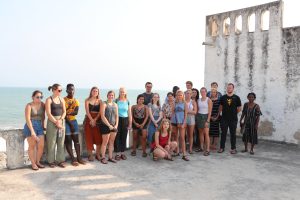
We learned that the officials of the castle would look down upon the women and select one of them to bathe in water from the well. They would then be brought up to the officers quarters were they would be sexually abused. If these women did not comply with these disgusting sexual demands they were at risk of significant punishment or even death. It was horrible and eye opening to see the juxtaposition of the luxurious officers quarters right above the slave dungeons, especially knowing about the horrible events that transpired there. Second, we saw a metal ball that female slaves would be chained to if they were not submissive to the officials.
They would be forced to stand in the hot sun while chained to this ball until their officials believed that they had been sufficiently punished.
We then went to the men’s slave cells. These cells were similar to the female cells, although they were smaller and much darker. There also would be many more slaves held in these confined spaces, as 600 male slaves would be held at a time. Alex told us that a few years ago they had 60 volunteers (much less than the amount of slaves that would be held in these cells) volunteer to be confined in these cells as an experiment. After only 12 hours the volunteers found the experience to be unbearable both physically and psychologically. Knowing that 60 people could not even handle 12 hours made for a much more powerful experience, as slaves would be held for many months at a time.
After seeing the men’s cells we then moved onward to the gate of no return.
On the bus ride to Elmina Castle, Prof. Abdulai told us that the phrase “gate of no return,” is a physical exit point from the castles onto the waiting boats, but also symbolizes the forced migration and the dispersal of the African people.
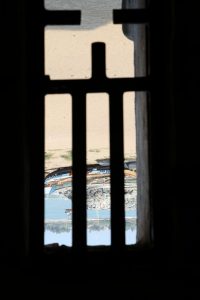
This is a small gate located in a confined part of the castle that is of incredible significance. This gate is the point at which slaves would be sent from the castle to the slave ships waiting at the beach. Once somebody had gone through this gate they were essentially considered to be a lost cause, as they were on their way towards a horrible life of slavery, never to return. Seeing this location was a powerful experience as it was the point at which hundreds of thousands of individuals were sent away never to be seen again. At one point an individual from our group asked Alex why the gate was so small, as it was notably narrow. Alex provided a morbid explanation, as he told us that by the time slaves were ready to be shipped off, their bodies would be so emaciated that there would never be any issue of them getting through the gate. This was intentional, as slave traders knew that if slaves were kept weak then there would be minimal chance of revolt. Furthermore, the death of slaves on their voyage was a point of minimal concern as a slave in the Americas could be sold for 20x more than in Africa.
Visiting the castles was an emotional part of the trip for the group. We started our journey in the Northern region of Ghana visiting slave camps and markets and then worked our way down to the castles on the coast, where the story comes to an end. As a group we have had many discussions regarding this journey the slaves endured, but seeing it made the texts become a sobering reality of the horrors that took place. After our tour, we had a brief moment of reflection, and then headed back on the bus to Accra. Back at the Pink Hostel, our dinner was delicious as always.
Mac, Maggie, Tina, and Clara
